How Has Being Multi-racial Changed Over Time?
 Multiracial identity is not just the sum of the races on someone's family tree. It'due south more complicated than that.
Multiracial identity is not just the sum of the races on someone's family tree. It'due south more complicated than that.
How you were raised, how you run into yourself and how the earth sees you have a profound effect in shaping multiracial identity, the survey finds. For many mixed-race Americans, these powerful influences may be equally important every bit racial background in shaping their racial identity.
In fact, when asked, "Do yous consider yourself to exist mixed race or multiracial, that is, more than i race, or not?," a substantial majority of Americans with a groundwork that includes more than than 1 race (61%) say that they practice non consider themselves to be multiracial.45
When asked why they don't identify as multiracial, virtually half (47%) say it is considering they wait like ane race. An identical proportion say they were raised as ane race, while near four-in-ten (39%) say they closely place with a unmarried race. And about a third (34%) say they never knew the family member or ancestor who was a different race. (Individuals were allowed to select multiple reasons.)
This multiracial "identity gap" plays out in distinctly different ways in dissimilar mixed-race groups.
A quarter of biracial adults with a white and American Indian background say they consider themselves multiracial, for example.
By dissimilarity, seven-in-x white and Asian biracial adults and 61% of those with a white and black background say they identify as multiracial. Multiracial adults with a white, blackness and American Indian racial background (50%) or a blackness and American Indian biracial background (33%) fall between these groups in terms of the share who say they identify as multiracial. Among Hispanics who count two or more than races in their groundwork, about six-in-10 (62%) say they consider themselves to be multiracial.
The survey as well finds that the mode in which people describe their ain racial groundwork doesn't ever friction match the manner they believe others meet them. About 9-in-10 white and American Indian biracial adults (88%) believe that a stranger passing them on the street would say they were single-race white; only 2% say they would be seen as multiracial and 7% equally American Indian only.
By contrast, half-dozen-in-x Americans with a white and black groundwork (61%) believe they are seen as black; simply 19% say they would be seen as multiracial (an boosted 7% say they would be perceived as white merely). Among white and Asian biracial adults, 42% say others would perceive them equally white and 23% think others see them every bit Asian. Ii-in-ten say they would be seen as multiracial.
Measuring multiracial identity is complicated for other reasons. Many mixed-race Americans say that over the form of their lifetimes they accept inverse how they viewed their racial identity. According to the survey, about three-in-10 mixed-race adults (29%) who now report more than one race for themselves say they used to see themselves as just one race. But amidst those who did non written report more than ane race for themselves in this survey—but instead are included in the multiracial group because of the races they reported for their parents or grandparents—an identical share have switched their racial identity: 29% say they once saw themselves equally more than than one race simply at present run into themselves as 1 race.
The survey too shows multiracial adults sometimes experience pressure to place as a single race. About one-in-5 mixed-race adults (21%) say they have been pressured by friends, family members or "club in general" to identify as a single race.
The residuum of this affiliate examines in more than item the multiracial identity gap and how concrete appearance, personal values, societal pressures and other factors help shape an individual's racial identity.
Sometimes I identify as white because it's easy. … Sometimes I merely become tired of explaining who I am, and sometimes I just don't intendance to. I as well recognize that since I look white I sometimes place that way because I know that's what they think.White and American Indian biracial adult female, age 27
A Mixed Racial Background, simply Non Multiracial
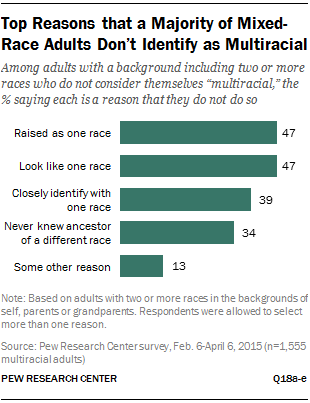 Only most four-in-ten adults (39%) with a background including more than one race consider themselves to be multiracial, while the majority of these adults (61%) do not.
Only most four-in-ten adults (39%) with a background including more than one race consider themselves to be multiracial, while the majority of these adults (61%) do not.
Amongst adults with multiple races in their background who do non consider themselves to be multiracial, almost half say their physical appearance (47%) and/or family upbringing (47%)—nature and nurture—are amid the reasons that they do not identify every bit multiracial. Some 39% say they closely place with 1 race, and well-nigh a tertiary (34%) say they never knew their family member or ancestor who was a different race.
An additional 13% give some other reason for not identifying as multiracial, including iv% who say their racial background is unimportant to them, 2% who say the family member of a different race is likewise many generations removed and two% who simply don't identify with their multiracial heritage.
Fading Multicultural Identity
The survey finds that multiracial identity quickly fades with the generations. Among those whose ties to a mixed racial groundwork come from a great-grandparent or earlier antecedent—a grouping that is non included among the assay of multiracial Americans throughout this written report—only 13% consider themselves to be multiracial. The share roughly doubles (to 28%) if a grandparent had a racial groundwork that was different from that of the respondent and his or her parents, and it rises to 35% if 1 or both parents had a different racial background than the respondent.
I place with the African-American culture more. One considering I simply expect it. When an average person is walking downwards the street, they just see a guy who is colored. A man of color. Brown.Black and Asian biracial human, age 47
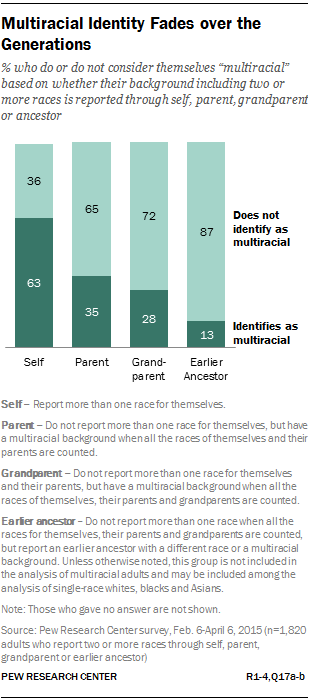 Amidst those who report that they themselves are two or more races, well-nigh vi-in-ten (63%) identify every bit multiracial. Simply fifty-fifty for this grouping, roughly a third (36%) exercise non consider themselves mixed race.
Amidst those who report that they themselves are two or more races, well-nigh vi-in-ten (63%) identify every bit multiracial. Simply fifty-fifty for this grouping, roughly a third (36%) exercise non consider themselves mixed race.
And it is among this group, the 36% who self-report that they are two or more races but don't consider themselves multiracial, that the power of physical appearance to shape racial identity comes into focus. Among these mixed-race Americans, the proportion who say they do not identify as multiracial considering they "look like 1 race" increases from 47% (among all multiple-race adults who exercise not consider themselves multiracial) to 64%. Near half (54%) of this group says the reason is that they were raised as only 1 race, while somewhat fewer (45%) say they closely identify as just i race. A 3rd (33%) say they don't identify every bit mixed race because they never knew their ancestor of a different race.
How Biracial Adults Think Others See Them
How practice multiracial adults believe strangers passing them on the street run into their racial background? The answer to that question varies substantially past mixed-race group. But one common thread runs through these responses: Few say they are viewed as multiracial.
Co-ordinate to the survey, only 9% of all multiracial adults believe they are perceived as a mix of races by others.
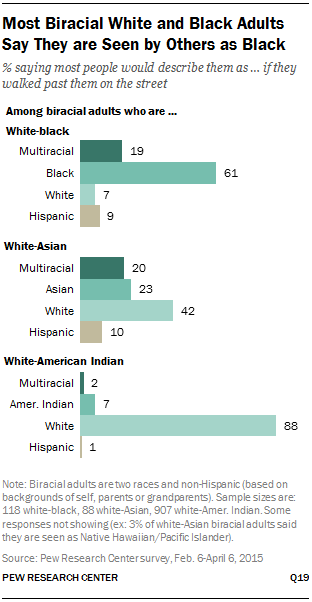 Amongst biracial adults who are white and black, 61% say they are perceived by strangers to exist black. Just 19% say they are seen equally multiracial, and even smaller shares say they are seen equally single-race whites (7%). About one-in-x (ix%) of non-Hispanic white and black biracial adults say others would recollect they are Hispanic, and three% say others would remember they are American Indian.
Amongst biracial adults who are white and black, 61% say they are perceived by strangers to exist black. Just 19% say they are seen equally multiracial, and even smaller shares say they are seen equally single-race whites (7%). About one-in-x (ix%) of non-Hispanic white and black biracial adults say others would recollect they are Hispanic, and three% say others would remember they are American Indian.
A about identical blueprint appears among black and American Indian biracial adults. Among this group, roughly viii-in-ten (84%) say strangers would place them as single-race black (six% say they would be seen as multiracial). And about six-in-ten white, blackness and American Indian multiracial adults (62%) also say others perceive them to be black (with 20% saying they would be seen as multiracial).
A significantly different design emerges among white and Asian biracial adults. Only about a quarter of this grouping (23%) says they are viewed as Asian, while 42% believe they are perceived as white. 1-in-five white and Asian biracial adults say they are seen as having a multiracial groundwork.
The overwhelming majority of white and American Indian biracial adults (88%) say they are seen every bit white. But 2% say they are thought to be multiracial, and 7% believe they are seen as Native American. Even amongst those who consider themselves to exist multiracial, eight-in-ten say they are perceived as white past others.
Amidst Hispanics who are more than one race, about a quarter (24%) say that a stranger would see them as Latino while 17% believe they would be viewed as multiracial.
It'southward often funny and interesting to see people's reactions when I practise tell them that I'm actually half Japanese. 'Oh, actually?. … I gauge I tin can come across it. Your cheekbones or maybe a little chip in your eyes.' But most people, say 8 out of 10, don't encounter it at all.White and Asian biracial woman, historic period 43
Attempts to Influence How Others Run across Their Appearance
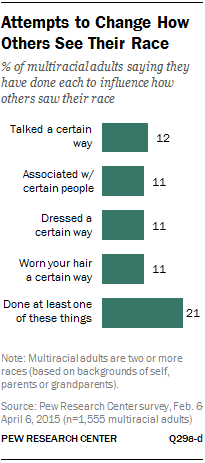 At some point in their lives, most 1-in-five multiracial adults (21%) have dressed or behaved in a certain way in order to influence how others saw their race.
At some point in their lives, most 1-in-five multiracial adults (21%) have dressed or behaved in a certain way in order to influence how others saw their race.
According to the survey, about one-in-ten multiracial adults have talked (12%), dressed (xi%) or worn their hair (11%) in a certain fashion in order to affect how others saw their race.
A like share (11%) say they associated with certain people to alter how others saw their racial identity. (The survey did not ask respondents to identify which race or races they sought to resemble.)
Efforts to affect perceptions by looking or behaving in a certain way varied widely across the largest multiracial groups.
Nigh four-in-10 (42%) black and American Indian biracial adults say they have presented themselves in a sure way in social club to affect how others saw their race. A tertiary of all adults with a white, blackness and American Indian background and nearly the aforementioned share (34%) of multiracial Hispanics also say they take made an endeavour to alter the way people see their race.
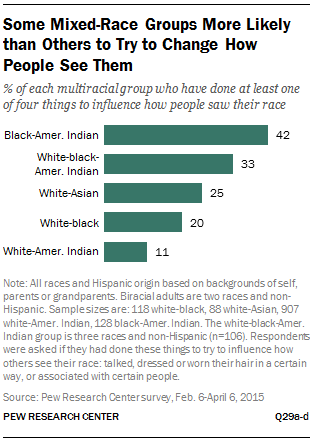 A quarter of white and Asian biracial adults and ane-in-five white and black biracial respondents say that, at some betoken, they have tried to look or behave a certain way to influence how people thought about their race. Among the largest biracial subgroup—white and American Indian adults—only about one-in-x (11%) say they take done this.
A quarter of white and Asian biracial adults and ane-in-five white and black biracial respondents say that, at some betoken, they have tried to look or behave a certain way to influence how people thought about their race. Among the largest biracial subgroup—white and American Indian adults—only about one-in-x (11%) say they take done this.
The survey also found that few multiracial adults take attempted to recast their racial identity to gain advantage when applying for college or scholarships.
Overall, merely 5% of all mixed-race adults who have at least some college didactics say they have described their racial background differently than they commonly would to get into college or authorize for a scholarship, including 13% of multiracial adults with an Asian background, vi% of black multiracial adults and 5% of mixed-race whites. (The survey did not inquire how they described their identity differently.)
Growing upwards I recall wanting to get a relaxer for my hair. Even as a guy, I wanted my hair when it got wet to sort of fall down or have spikes. I wanted to dress a certain way because I wanted to embrace what I thought was … a white identity.White and black biracial human, age 25
Pressure to Identify as 1 Race
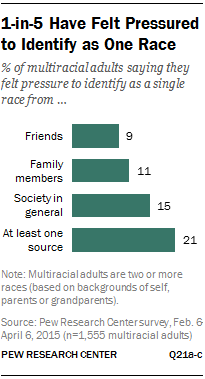 About 1-in-five multiracial adults (21%) say they have felt force per unit area from friends, family or from society in general to cull one of the races in their background over some other.
About 1-in-five multiracial adults (21%) say they have felt force per unit area from friends, family or from society in general to cull one of the races in their background over some other.
Multiracial adults experience the estrus to place equally just one race more than from "society in full general" (15%) than from family unit members (11%) or friends (9%). (The survey did non ask respondents with which race they felt pressured to identify.)
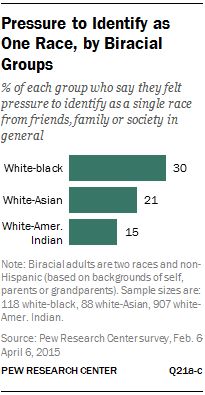 Multiracial adults with a black groundwork are among the well-nigh likely to say they have felt pressure to identify as single race from at least ane of the three sources tested in the survey. Most iii-in-ten biracial adults who are white and black (thirty%) or blackness and American Indian (28%) autumn into this category.
Multiracial adults with a black groundwork are among the well-nigh likely to say they have felt pressure to identify as single race from at least ane of the three sources tested in the survey. Most iii-in-ten biracial adults who are white and black (thirty%) or blackness and American Indian (28%) autumn into this category.
Roughly three-in-10 multiracial Hispanics (31%) and about two-in-x adults with a white, blackness and American Indian racial background (23%) or a biracial white and Asian background (21%) also felt pressured. Some 15% of white and American Indian biracial adults felt pressed to say they are ane race. The pressure to identify with a single race is especially felt by those who believe they physically look like a mix of races and not like just i race. According to the survey, about a tertiary (34%) of all mixed-race adults who say a passerby would identify them equally multiracial also say they take felt force per unit area to place every bit 1 race. By contrast, some xx% of those who believe that a stranger would place them as single race or as Hispanic only say they have felt similar pressure.
Changes in Identity over the Life Grade
An individual'southward racial background is fixed at nascency just his or her racial identity can modify over the course of a lifetime, the Pew Inquiry survey found.
About iii-in-ten adults (29%) who at present think of themselves equally more than than 1 race say they once thought of themselves equally but i race. An identical share moved the opposite way: 29% of those who have a mixed racial background but see themselves every bit only ane race say they used to think of themselves as more 1 race.
At that place was a time when I didn't identify as black. In fact, growing up I really hung onto this idea that I was biracial. … It wasn't 'til higher that I fabricated that switch from identifying as biracial to beingness black.White and black biracial man, age 25
Multiracial Background and Personal Identity
 Multiracial adults and the general public by and large ascertain who they are around the same set of cadre characteristics and values, and they give the same relative importance to their racial groundwork. About half of all Americans (51%) say their gender is "essential" to their personal identity, and most the same proportion of multiracial adults agrees (50%). Identical proportions (39%) of mixed-race Americans and the land as a whole say their faith is an essential office of who they are. Near a quarter of both groups also say their racial groundwork and their family unit ancestry are extremely of import elements of their personal identity, while about i-in-v of both groups charge per unit their occupation equally essential to their personal identity.
Multiracial adults and the general public by and large ascertain who they are around the same set of cadre characteristics and values, and they give the same relative importance to their racial groundwork. About half of all Americans (51%) say their gender is "essential" to their personal identity, and most the same proportion of multiracial adults agrees (50%). Identical proportions (39%) of mixed-race Americans and the land as a whole say their faith is an essential office of who they are. Near a quarter of both groups also say their racial groundwork and their family unit ancestry are extremely of import elements of their personal identity, while about i-in-v of both groups charge per unit their occupation equally essential to their personal identity.
Multiracial adults and other Americans fifty-fifty concord on the least important of the half dozen characteristics tested in the survey. Only nigh one-in-ten multiracial adults (ten%) and adults in the full general public (xi%) consider political affiliation to exist a cadre function of their identity.
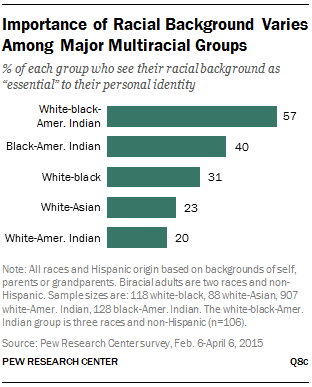 With a few notable exceptions, similar proportions among the v largest multiracial groups and mixed-race Hispanics say these traits and characteristics are essential to their sense of self.
With a few notable exceptions, similar proportions among the v largest multiracial groups and mixed-race Hispanics say these traits and characteristics are essential to their sense of self.
Large differences emerged on the relative value that black, white and Asian mixed-race groups placed on their race every bit well equally their family unit origin in determining their personal identity.
Overall, multiracial blacks are generally more likely than other mixed-race groups to see their racial groundwork and family ancestry or country of origin as of import parts of their personal identity.
For example, fully 57% of white, blackness and American Indian multiracial adults say their racial groundwork is essential to their sense of personal identity, roughly 3 times the share of white and Native American biracial adults (twenty%) who limited this view.
Four-in-10 blackness and American Indian biracial adults say race is an extremely important part of who they are, as do 31% of white and black biracial adults.
Among biracial white and Asian adults, 23% say their racial background is essential to their personal identity. Simply 15% of all multiracial Hispanics consider their racial mix to be cardinal to who they are.
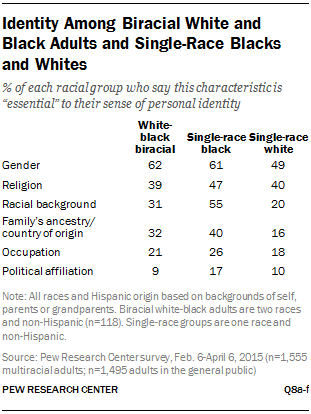 Significantly, the share of biracial adults with a white and black groundwork (31%) who view their race equally essential to their identity is essentially smaller than the proportion of single-race blacks (55%) who hold the same view. Single-race white adults are somewhat less probable than biracial white and blackness adults to consider their racial background to exist an essential part of their overall identity; merely 20% say it is.
Significantly, the share of biracial adults with a white and black groundwork (31%) who view their race equally essential to their identity is essentially smaller than the proportion of single-race blacks (55%) who hold the same view. Single-race white adults are somewhat less probable than biracial white and blackness adults to consider their racial background to exist an essential part of their overall identity; merely 20% say it is.
Multiracial blacks are more probable than other multiracial groups to consider their family beginnings or land of origin as cardinal to their identity. For case, nigh a third (32%) of white and black biracial adults say their family unit ancestry is essential to their sense of who they are, double the proportion of white and American Indian biracial adults who concur that view. About four-in-10 black and American Indian adults (36%) and multiracial white, black and American Indian adults (42%) say their family'due south ancestry or country of origin is essential to their identity. Among white and Asian biracial adults, 21% say this, equally do 12% of multiracial Hispanics.
Most of the world sees me as white, but on a personal, more emotional level, I connect very strongly to [the Catawba tribal] customs that I grew up with because it'southward my family.White and American Indian biracial man, age 23
Source: https://www.pewresearch.org/social-trends/2015/06/11/chapter-3-the-multiracial-identity-gap/
Posted by: baileythoseltogs.blogspot.com


0 Response to "How Has Being Multi-racial Changed Over Time?"
Post a Comment